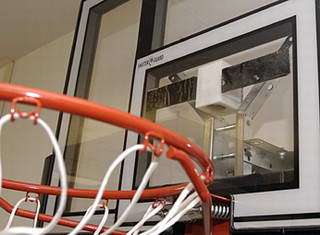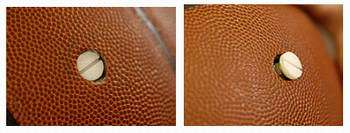Engineers devise basketball system for the blind

Three Johns Hopkins engineering undergraduates - two of them starters on the women's basketball team - have designed and built a system that uses sound emitters in the ball and on the backboard to enable blind people to play basketball.
Image: The white box behind the backboard houses a sound emitter that helps the player hear where the shooting target is located. Photo by Will Kirk
"There are people all over the country who are waiting for something like this," said Mike Bullis, business services development manager for Blind Industries and Services of Maryland, a group that aids the visually impaired and sponsored the research project. "There are blind athletes who want an audible ball. And there are school- age children who can benefit from the hand coordination that comes from playing ball. Right now, blind kids can play with a ball, but only if someone is there to find it if it rolls away."
During a recent demonstration, Bullis, who is blind, was able to catch passes with the adapted ball and sink baskets on two of his three shots.

The Johns Hopkins students who devised the system were enrolled in a two-semester engineering design course in the Department of Mechanical Engineering. The project was particularly meaningful for two of the student inventors, Alissa Burkholder and Ashanna Randall. While completing their rigorous engineering studies, the two also played for four years on the Johns Hopkins women's basketball team, a perennial Centennial Conference and NCAA Division III contender. During their senior year, Burkholder, a shooting guard, and Randall, an all-conference small forward, were major contributors to the team's third straight season of 20-plus wins.
Last fall, when they and other students in the design course were asked to rank the project they'd most want to be involved in, Burkholder and Randall, not surprisingly, chose the audible basketball system. "I really liked that it involved basketball and that it was something to help the disabled community," said Burkholder, 22, an engineering mechanics major from Allentown, Pa.
She was assigned to the audible basketball design team with fellow seniors Randall, 22, a mechanical engineering major from Media, Pa., and Steve Garber, 21, a mechanical engineering major from Lugoff, S.C.
In their completed system, a large piezoelectric sound emitter powered by a 9-volt battery and mounted behind the backboard sends out low pulse tones to help players locate their shooting target. A remote control is used to turn it on and off. A smaller sound emitter, embedded in the basketball and powered by five 3-volt button batteries, sends out a higher continuous tone to tell players where the ball is.
Bullis, representing the project's sponsor, cautioned that this prototype system is not perfect. The basketball's sound pitch needs to be lowered for the comfort of players and to avoid echo problems, which would sometimes make it difficult for a blind player to identify the ball's location. Bullis plans to consult a sports equipment maker about modifying the pitch. He also hopes to persuade a company to install the system in other sports items, including soccer balls and volleyballs. "The process is ongoing," he said. "But I think we'll end up with an audible ball that's going to be a huge asset to the blind community."
When the student engineers designed the system, a key hurdle was how to create a cavity in a ball to hold the electronics, while keeping it airtight. "We discovered that it's really hard to put a device inside a ball in a way that wouldn't change its characteristics," Randall said. "Weight was a consideration. If the device was too heavy, the ball wouldn't bounce or roll properly."
In their research, however, the students discovered the Spalding Infusion basketball, which is equipped with a airtight cylinder that houses a small pump. The company provided several Infusion balls for the students to cut open and study. Spalding then provided five additional basketballs that had just the cylinder in them without the pump. That gave the students a small space in which to insert a sounding device and batteries. The opening's small size limited their options and led to a relatively high-pitched sounder. However, the students also came up with an idea for an alternate mini-speaker system that should emit a lower pitch. They provided details on this alternative to the sponsoring organization, for possible future developmental work.
"I don't think it's fully developed, but it's definitely a great start," Randall said.
Burkholder added, "I've been playing basketball so long, and it's something I really enjoy. It's nice to be able to share that with people who wouldn't otherwise be able to play."
With their Johns Hopkins studies completed, Garber and Randall have already lined up research-related jobs. Burkholder will enter a master's degree program in mechanical engineering at Stanford University. The students said the senior design project course was a valuable learning experience. "We learned how to interact with real-world companies," Burkholder said. "We also learned how to work with teammates and to compromise and to get different ideas to mesh."
Added Garber: "I got a taste of what a real engineering job will be like. We had a lot of deadlines to meet and reports to write and revise. But it was cool to get our hands on a real project."
The basketball system for the blind was one of nine Johns Hopkins projects completed this year by undergraduates in the engineering design course. The class is taught by Andrew F. Conn, a Johns Hopkins graduate with more than 30 years of experience in public and private research and development. Each team of three or four students, working within budgets of up to $10,000, had to design a device, purchase or fabricate the parts, and assemble the final product. Corporations, government agencies and nonprofit groups provided the assignments and funding. The course is traditionally a well-received, hands-on engineering experience for Johns Hopkins undergraduates.
Source: Johns Hopkins University















